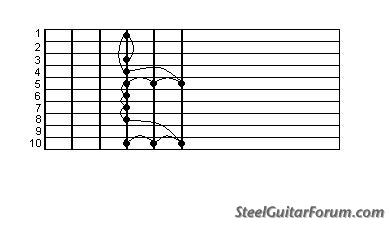Hey Ben, here's a really simple connect-the-dots "blues box" in the key of A at frets 3 and 5 on E9 no pedals. It's baby steps, like you were talking about:

Then, if you were to press your B pedal (raises strings 3 and 6 a half step) it'd look like this:

If I weren't supremely lazy I'd post another diagram showing how handy the A pedal would be with those notes on strings 10 and 5, particularly if you were to "half-pedal" some of the notes.
Also, if you have the change on your guitar that lowers string 9 a half step and lowers string 2 a whole step, you could play the whole thing like this:
(in the tab below, # means raise a half step, ## means raise a whole step, b means lowers a half step, bb means lowers a whole step)
[tab]
1_______________________________________3_______________
2_____________________________3bb_______________________
3_____________________________________________3#________
4___________________________________3___________________
5_____________________3___3#____________________________
6__________________3#___________________________________
7_______________3_______________________________________
8____________3__________________________________________
9_________3b_____________________________________________
10__3__3#________________________________________________[/tab]
Jim, I tried to put one of these together for your tuning, but my head started to hurt. I'm sure it's there, but I'd have to sit at a guitar with your tuning on it. My brain, it is kaput.



